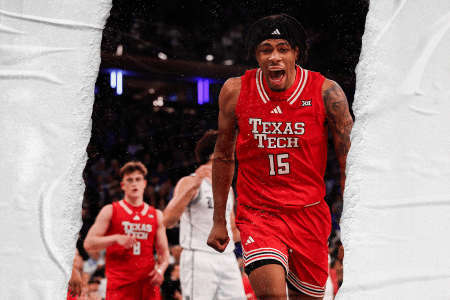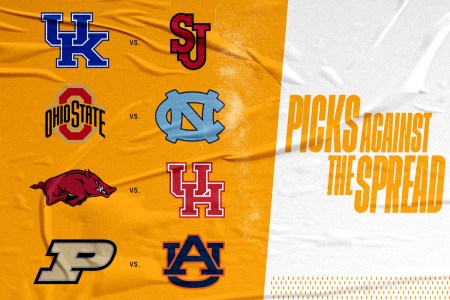There is a buzz around Georgia men’s basketball right now, one that has been gradually building since coach Mike White took over the program in 2022. It reached a new high during the 2024-25 campaign, as the Bulldogs finished 20-13 and made their first NCAA Tournament appearance in a decade. Georgia also earned its first AP top 25 ranking since 2011, coming in at No. 23 in the Jan. 13 poll. “There’s a lot of excitement around here,” White tells Hoops HQ. “Our students were incredible throughout the year. Our administration has been incredibly supportive in helping us rebuild this program.”
The excitement is back in Athens, but with it comes greater expectations. The Bulldogs have improved every season under White — can they do it again in 2025-26? “We’ve got a lot of momentum,” White says. “We’ve just got to continue to ride that momentum and get better as a program.”
It will be a major challenge considering the program’s heavy roster turnover and the level of competition in the SEC. Gone are centerpieces Asa Newell, a 6-foot-11 freshman forward who declared for the NBA draft (where he is likely to be a lottery pick), and Silas Demary Jr., a 6-foot-5 sophomore guard who transferred to UConn. Newell led the Bulldogs in scoring and rebounding, while Demary was their primary playmaker. Georgia lost two additional starters in 6-foot-4 guard Tyrin Lawrence (out of eligibility) and 6-foot-7 forward RJ Godfrey (transferred to Clemson), as well as sixth man Dakota Leffew (out of eligibility).
A handful of players will return to the program, including starting wing Blue Cain, a 6-foot-5 sophomore who averaged 9.6 points per game, 6-foot-11 freshman center Somto Cyril and 6-foot-9 sophomore forward Dylan James. Building around that nucleus, the staff has been assembling a group that will play a very different style than previous Georgia teams. White hit the transfer portal determined to address two areas where the Bulldogs have struggled immensely: perimeter shooting and assist-to-turnover ratio. “I went into it saying, I’m sick of not being able to shoot it better,” White explains. “And also the turnover problem. We finished at about one-to-one (assist-to-turnover ratio), which is just not getting it.”

Those issues have been persistent throughout White’s three seasons at the helm. This past year, the Bulldogs ranked 236th in Division I in three-point percentage (32.9 percent), 271st in three-pointers per game (6.9) and 298th in assist-to-turnover ratio (0.96). In their 89-68 loss to Gonzaga in the first round of the NCAA Tournament, they shot 5-of-26 from deep and had more turnovers (13) than assists (12).
With those deficiencies in mind, White and his staff have been very active in the portal, securing commitments from five players: 6-foot-9 freshman forward Kanon Catchings (BYU), 5-foot-11 sophomore guard Marcus “Smurf” Millender (UTSA), 6-foot-3 junior guard Justin Bailey (Wofford), 6-foot-3 sophomore guard Jordan Ross (Saint Mary’s) and 6-foot-1 freshman guard Jeremiah Wilkinson (California).
Catchings, a former top-40 recruit known for his outside shooting, averaged 7.2 points and connected on 35.0 percent of his threes for the Cougars. With his size, skill set and versatility, Catchings will be closely monitored by NBA scouts next season. “He’s got to continue to round out his game offensively to compliment his ability to shoot the three,” says White. “And then defensively, his ceiling is very high too, with his length, speed, quickness and switch-ability.”
White added two more perimeter threats in Millender (43.8 percent from three) and Bailey (45.6 percent). Millender, who had an assist-to-turnover ratio of 2.0 last season, is a reliable ball-handler and playmaker. Bailey was a key contributor on a Wofford team that won the Southern Tournament, posting 19 points and 7 rebounds in the championship game against Furman. He was named to the conference’s All-Defensive team as well.
Ross, who averaged 8.3 points, 3.1 rebounds, 2.6 assists and 0.8 turnovers for the Gaels, is expected to replace Demary as Georgia’s starting point guard. “I know he played off the ball at St. Mary’s, a top 25 team, a conference champion,” says White. “(With a) 3-to-1 assist-to-tournover, he’s going to get more usage at the point. I think he’s a very good passer.” Much of Georgia’s success will hinge on how well Ross adapts to his new role.

Wilkinson, the reigning ACC Sixth Man of the Year, will share on-ball duties with Ross and Millender. The Georgia native is coming home after one season at Cal, where he averaged 15.1 points. His shooting was inconsistent, but his ability to create off the bounce and get to the free throw line will be crucial with Newell and Demary out of the picture. Wilkinson started his final 14 games for the Golden Bears and boosted his scoring average to 19.5 points over that span.
“They all can score it,” White says about his transfer class, which is ranked No. 37 in the country by 247Sports. “Overall, I just feel like we’ve gotten a lot better with passing it (and) decisions. If you look at the volume of threes made with the guys we signed — and then returning Blue and we have to get Dylan’s confidence back up the way he shot it his freshman year — we ought to look like a completely different team offensively from those standpoints.”
Throw in three dynamic high school recruits with tremendous upside — 6-foot-8 forward Jacob Wilkins (four-star), 6-foot-8 forward Kareem Stagg (four-star) and 7-foot-1 center Jackson McVey (three-star) — and Georgia’s 2025-26 roster is nearly complete. Wilkins, who is the son of NBA legend and Georgia alum Dominique Wilkins, is the No. 53rd-ranked prospect in the class of 2025, according to ESPN. White says Wilkins will be “one of the better athletes that I’ve ever had the opportunity to coach, with incredible length and the ability to change ends and sprint into jump shots.”
After ranking 219th in pace in 2024-25, the Bulldogs will play much faster next season given their personnel. White will also utilize more four-guard lineups that space the floor around starting center Somto Cyril. The staff anticipates Cyril, who led Georgia in blocks per game (1.5) and field goal percentage (62.6 percent) in limited minutes off the bench, making a big leap as a sophomore. “The more minutes he logs, the more different we can be defensively in terms of extending pressure and picking our spots because of his ability to block shots,” White says. “And then I think the more he plays, the more we’re going to block and alter (shots), the more that’s going to help us get out in transition and play faster offensively.”
Georgia hasn’t made the splashiest offseason moves, but it has stuck to and executed its game plan well. The program should be much improved in the areas that ultimately led to its demise last season. If the pieces come together in the way that White envisions, then the Bulldogs should make noise once again. “We feel like we signed good players, but even better human beings,” White says. “We’ve got a locker room full of great kids and we’re optimistic that it’ll all fit really well.”












